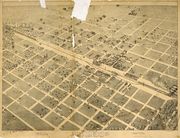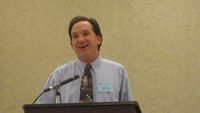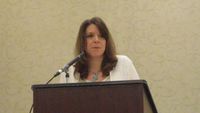Abilene, Texas
| City of Abilene | |
|---|---|
| — City — | |
|
|
|
 |
|
| Coordinates: | |
| Country | United States |
| State | Texas |
| Counties | Taylor & Jones |
| Government | |
| - Mayor | Norm Archibald |
| Area | |
| - City | 110.6 sq mi (286.5 km2) |
| - Land | 105.1 sq mi (272.3 km2) |
| - Water | 5.5 sq mi (14.2 km2) |
| Elevation | 1,719 ft (524 m) |
| Population (2000) | |
| - City | 115,930 |
| - Density | 1,102.8/sq mi (425.8/km2) |
| - Urban | 107,041 |
| - Metro | 160,245 |
| - Demonym | Abilenian |
| Time zone | CST (UTC-6) |
| - Summer (DST) | CDT (UTC-5) |
| ZIP codes | 79600-79699 |
| Area code(s) | 325 |
| FIPS code | 48-01000[1] |
| GNIS feature ID | 1329173[2] |
| Website | http://www.abilenetx.com/ |
Abilene (pronounced /ˈæbəliːn/ "ABBA-leen") is a city in Taylor and Jones counties in west central Texas. The population was about 120,000 in 2008. It is the principal city of the Abilene Metropolitan Statistical Area, which had a 2006 estimated population of 158,063. It is the county seat of Taylor County.[3] Dyess Air Force Base is located on the west side of the city.
Abilene is located off Interstate 20, between exits 279 on its western edge and 292 on the east. Abilene is 150 miles (240 km) west of Fort Worth, Texas. The city is looped by I-20 to the north, US 83/84 on the west, and Loop 322 to the east. A railroad divides the city down the center into north and south. The historic downtown area is on the north side of the railroad.
The fastest-growing sections of the city are growing to the southwest, along Southwest Drive, the Winters Freeway, and the Buffalo Gap Road corridor; the southeast, along Loop 322, Oldham Lane, Industrial Drive, and Maple Street; and in the northeast near the intersection of SH 351 and I-20. Many developments have begun in these three areas within the last few years. There are three lakes in the city, Lytle Lake on the western edge of Abilene Regional Airport, Kirby Lake on the southeast corner of the US 83/84 & Loop 322 interchange, and Lake Fort Phantom in Jones County north of the city.
History

Established by cattlemen as a stock shipping point on the Texas and Pacific Railway in 1881, the city was named after Abilene, Kansas,[4] the original endpoint for the Chisholm Trail. The T&P had bypassed the town of Buffalo Gap, the county seat at the time. Eventually, a landowner north of Buffalo Gap, Clabe Merchant, known as the father of Abilene, chose the name for the new town. According to a Dallas newspaper, about eight hundred people had already begun camping at the townsite, before the lots were sold. The town was laid out by Colonel J. Stoddard Johnson, and the auction of lots began early on March 15, 1881. By the end of the first day, 139 lots were sold for a total of $23,810, and another 178 lots were sold the next day for $27,550.
In 1882, the town was incorporated, and Abilenians began to set their sights on bringing the county seat to Abilene and, in a three-to-one vote, won the election. In 1888, the Progressive Committee was formed to attract businesses to the area, which later became the Board of Trade in 1890. By 1900, 3,411 people lived in Abilene, and in that decade, the Board of Trade changed its name to the 25,000 Club in the hope of reaching 25,000 people by the next census. However this committee failed when the population only hit 9,204 in 1910. Replacing it was the Young Men's Booster Club, which became the Abilene Chamber of Commerce in 1914.
The cornerstone was laid for the first of three future universities in Abilene, called Simmons College, in 1891, which later became Hardin-Simmons University. Childers Classical Institute followed in 1906, currently Abilene Christian University, Abilene's largest of the three. In 1923, McMurry College was founded and later became McMurry University. Much more recently, Abilene succeeded in bringing Cisco Junior College and Texas State Technical College branches to Abilene, with the Cisco Junior College headquarters being located in Abilene.
In 1940, Abilene raised the money to purchase land for a U.S. Army base, southwest of town, named Camp Barkeley, which was at the time, twice the size of Abilene with 60,000 men. When the base closed, many worried that Abilene could become a ghost town, but in the post-World War II boom, many servicemen returned to start businesses in Abilene. In the early-1950s, residents raised $893,261 to purchase 3,400 acres (14 km2) of land for an Air Force base. Today, Dyess Air Force Base is the city's largest employer, with 6,076 employees.[5] [6] By 1960, Abilene's population nearly doubled in 10 years from 45,570 in 1950 to 90,638. In the same year, a second high school was added, Cooper High School. In 1966, the Abilene Zoo was created near Abilene Regional Airport. The following year, one of the most important bond elections in the city's history passed for the funding of the construction of the Abilene Civic Center and the Taylor County Coliseum, as well as major improvements to Abilene Regional Airport. In 1969, the Woodson elementary and high school for black students closed as the schools are integrated.
In 1982, Abilene became the first city in Texas to create a downtown reinvestment zone. Texas State Technical College opened an Abilene branch three years later. The 2,250-bed French Robertson Prison Unit was built in 1989. A half-cent sales tax earmarked for economic development was created after the decline in the petroleum business in the 1980s. A branch of Cisco Junior College was located in the city in 1990.
The Grace Museum and Paramount Theatre revitalizations, along with Artwalk in 1992 sparked a decade of downtown restoration. In 2004, Frontier Texas!, a multi-media museum highlighting the history of the area from 1780-1880 was constructed, and a new $8 million, 38-acre (150,000 m2) Cisco Junior College campus was built at Loop 322 and Industrial Boulevard. Simultaneously, subdivisions and businesses started locating along the freeway, on the same side as the CJC campus, showing a slow but progressive trend for Abilene growth on the Loop. Abilene has become the commercial, retail, medical, and transportation hub of a 19-county area more commonly known as "The Big Country," but also known as the "Texas Midwest". By the end of 2005, commercial and residential development had reached record levels in and around the city.[7]
Geography and climate
Abilene is located at (32.446425, -99.745482),[8] 160 miles (257 km) west by south of Fort Worth.
According to the United States Census Bureau, the city has a total area of 110.6 square miles (286.5 km²), of which, 105.1 square miles (272.3 km²) of it is land and 5.5 square miles (14.2 km²) of it is water (4.95%).
Abilene falls near the boundary between the humid subtropical climate and the semi-arid steppe climate.
| Climate data for Abilene | |||||||||||||
|---|---|---|---|---|---|---|---|---|---|---|---|---|---|
| Month | Jan | Feb | Mar | Apr | May | Jun | Jul | Aug | Sep | Oct | Nov | Dec | Year |
| Average high °F (°C) | 55 (12.8) |
60 (15.6) |
68 (20) |
78 (25.6) |
84 (28.9) |
91 (32.8) |
95 (35) |
94 (34.4) |
87 (30.6) |
78 (25.6) |
65 (18.3) |
58 (14.4) |
76 (24.4) |
| Average low °F (°C) | 32 (0) |
36 (2.2) |
43 (6.1) |
53 (11.7) |
61 (16.1) |
69 (20.6) |
72 (22.2) |
72 (22.2) |
65 (18.3) |
54 (12.2) |
42 (5.6) |
34 (1.1) |
53 (11.7) |
| Precipitation inches (cm) | 1 (3) |
1.1 (3) |
1.1 (3) |
2.1 (5) |
3.5 (9) |
2.8 (7) |
2.2 (6) |
2.4 (6) |
2.8 (7) |
2.5 (6) |
1.3 (3) |
1.1 (3) |
23.9 (61) |
| Source: weatherbase.com [9] | |||||||||||||
Demographics
As of the census[1] of 2000, there were 115,930 people, 2005 estimate placed the city's population at 120,021), 41,570 households, and 28,101 families residing in the city. The population density was 1,102.7 people per square mile (425.8/km²). There were 45,618 housing units at an average density of 433.9/sq mi (167.5/km²). The ethnic makeup of the city was 78.07% White, 8.81% African American, 0.55% Native American, 1.33% Asian, 0.07% Pacific Islander, 8.73% from other races, and 2.44% from two or more races. Hispanic or Latino of any race were 19.45% of the population.
There were 41,570 households, of which 34.2% had children under the age of 18 living with them, 52.0% were married couples living together, 11.9% had a female householder with no husband present, and 32.4% were non-families. About 26.6% of all households were made up of individuals, and 9.8% had someone living alone who was 65 years of age or older. The average household size was 2.53 and the average family size was 3.07.
In the city the population was distributed as 25.6% under the age of 18, 15.3% from 18 to 24, 28.9% from 25 to 44, 18.2% from 45 to 64, and 12.0% who were 65 years of age or older. The median age was 31 years. For every 100 females there were 102.0 males. For every 100 females age 18 and over, there were 101.1 males.
The median income for a household in the city was $33,007, and the median income for a family was $40,028. Males had a median income of $28,078 versus $20,918 for females. The per capita income for the city was $16,577. About 10.9% of families and 15.4% of the population were below the poverty line, including 18.6% of those under age 18 and 9.2% of those age 65 or over.
Government and infrastructure
The Texas Department of Criminal Justice (TDCJ) operates the Abilene District Parole Office in the city.[10] The Robertson Unit prison and the Middleton Unit transfer unit are in Abilene and in Jones County.[11][12][13]
The United States Postal Service operates the Abilene Post Office and the Abilene Southern Hills Post Office.[14][15]
Education



Abilene has two school districts within the city limits, the Abilene Independent School District (AISD) and Wylie Independent School District (WISD). The local high schools are Abilene High School and Cooper High School of AISD and Wylie High School of WISD. A new building on the Hardin-Simmons University campus serves AISD high school students as a magnet school, called Holland Medical High School, as well as HSU students as the Holland School of Sciences and Mathematics. The Holland Medical High School is affiliated with Hendrick Medical Center, which is across Ambler Avenue from the university campus. Abilene also has a new high school that opened in the fall of 2009, the Academy of Technology, Engineering, Mathematics, and Science (A.T.E.M.S.). It is a S.T.E.M. school, which focuses on computer science, engineering science, and mathematics. The school only accepts about 100 students each year, and provides students with their own laptop computers.
AISD has begun taking steps towards creating magnet schools for the school district. The district is currently considering locating a specialized math and science classroom at McMurry University, taught by both a university professor and AISD teacher, on the campus. A plan for the future calls for the creation of a magnet school system specializing in four areas: math, science, technology, and fine arts. The four areas will be divided among each of the four middle schools in the district. Regular curriculum will still be taught, but extra emphasis and equipment would be given based on the specific field of the school, such as extra labs for a science school, and an instrument lab for a fine arts school.[16] Also, Bond Proposition 2 for the 2008 AISD bond election proposed a new Professional and Technology magnet school to be located at Lincoln Middle School,[17] one of the oldest schools in the city, after a major renovation project.
The city is also home to several higher education units, including three religiously affiliated private universities: Abilene Christian University (ACU), Hardin-Simmons University (HSU), and McMurry University (McM), as well as the Abilene campus of Cisco Junior College (CJC), a West Texas campus of Texas State Technical College (TSTC), and American Commercial College (ACC). In addition, a new Texas Tech University Health Sciences Center School of Pharmacy was recently built in north Abilene.
Rankings
Abilene also ranked as the 17th city in the nation for their public education system, the highest ranked city in Texas. This award was given by Business Outlook Magazine in their September/October 2006 edition based on the following criteria.[18]
- average spending per student
- pupil/teacher ratio
- high school graduation rate
- highly educated population (percentage of pop. with 2-year, 4-year, or higher degrees)
- nearness to top-rated universities
Culture
The cultural aspects of Abilene center around a mix of the local college and university campuses, the agriculture community of the surrounding area, and the numerous evangelical churches present. The Abilene Arts Alliance captured the essence of the city with "Frontiering," a brand name for the city introduced in November 2008 to connect its pioneer spirit with its modern efforts to push the boundaries of education, technology, transportation, energy, the arts, and health care. Abilene is also home to the restored Paramount Theatre, The Abilene Philharmonic, The Grace Museum, the Center for Contemporary Arts, the National Center for Children's Illustrated Literature, The Abilene Zoo, Frontier Texas!, the 12th Armored Division Museum, Taylor County Coliseum, five libraries (3 private, 2 public), twenty-six public parks, six television stations and several radio stations, including one National Public Radio station (89.7 KACU).
George Hamilton IV had a country and pop hit in 1963 with a song about the city, simply entitled "Abilene". The city also plays an important part in Richard Kelly's 2007 film, Southland Tales, as well as his unproduced 1999 screenplay adaptation of Holes, both of which take place in the years following a nuclear attack on the city, where much of Kelly's family lives.
West Texas Historical Association


The West Texas Historical Association was chartered at the county courthouse in Abilene in 1924. Previously long associated with Hardin-Simmons University, the WTHA is now based at the Southwest Collection of Texas Tech University in Lubbock.[19]
At the 2010 WTHA annual meeting in Fort Worth, Robert C. "Rob" Fink, assistant professor of educational studies at Hardin-Simmons University, recalled the pending arrival for one day of Major League Baseball to Abilene. On November 4, 1913, the New York Giants and the Chicago White Sox were scheduled to play a end-of-season exhibition game at the then Simmons College baseball park. Pitcher Christy Mathewson was among the players on the tour. The Abilene community prepared to receive the All Star teams, schools were dismissed, and businesses closed for the afternoon of the game. On national tour, the teams had previously played in Marshall, Houston, and Dallas. After Abilene, the railroad carried the players on to El Paso. After so much community preparation, the much anticipated game in Abilene never happened. A norther passed through Abilene on the night of November 3, and the rains caused the cancellation of the pending game. Most of the players did not even leave the train when it reached Abilene.[20]
Fink and his wife, Tiffany Haggard Fink, a professor of the American West at Hardin-Simmons and the 2009-2010 president of the West Texas Historical Association, have co-authored the 2009 book, Love Unbounded: The Influence of First Baptist Church on Abilene, Texas. The work is an historical perspective on the relationship between First Baptist and the community.[21]
At the time of the 125th anniversary of the Abilene congregation, Fink said that he "began to think about the influence of First Baptist on Abilene, specifically the many other institutions in town started by the church. God put it on my heart to tell this story. I asked Tiffany if she would like to work with me on the project. As we researched, a mission spirit of First Baptist toward Abilene became clear. ..... The expression of love by First Baptist towards the community inspired me and shaped the book."
Tiffany Fink said that the joint study is "not only a history of the church in which we are active and the community in which we are living and raising our family, but also as a study of settlement and development in the American West and, in this case, West Texas."
Recreation and entertainment
Park system
The Abilene park system includes 29 parks, occupying a total of 1,247.56 acres (5.0487 km2). In addition, three athletic complexes located throughout the city are under the jurisdiction of the parks department.
The Abilene Zoo is a popular attraction in Abilene, boasting several hundred animals of hundreds of species. It hosts educational and summer programs as well as special events throughout the year. Currently, the zoo is undergoing expansion with the addition of a black rhino exhibit this year. Next to arrive will be South American Maned Wolves and cougars as well as an expanded giraffe exhibit and a wetlands exhibit. The Elm Creek backyard area will be built to house locally found animals such as armadillos, skunks, and river otters.
Events
The West Texas Fair & Rodeo, held annually for ten days in mid-September, features exhibits and amusements reflecting early days of Abilene, plus modern attractions of West Texas.
The Western Heritage Classic in early May features ranch rodeo, campfire cook-off, sheepdog trials, farrier competition, Cowboy Poets Society, a Western art show and many other activities.
On every second Thursday evening of the month, Artwalk is held in downtown Abilene. During Artwalk all the local museums are free, local musicians and performers busk, and several crafters and artists set up booths and sell their wares.
There are also several special-interest conventions, festivals, and shows scattered throughout the year, including the Abilene Gem and Mineral Show, the West Texas Book and Music Festival, the Abilene Gun and Knife Show, the Friends of the Abilene Public Library book sale.
Also of note is the annual Abilene High vs. Cooper High football game, the Crosstown Showdown, usually held near Halloween. Two of these games, in 2001 and 2002, were for the district championship and were called the “Showdown at Shotwell” games played at Shotwell Stadium.
Photo gallery
|
Abilene banner |
Federal Building (Courthouse and Post Office) in Abilene |
Abilene City Hall |
The Grace Cultural Center at the corner of North 1st and Cypress Street |
|
A statue inspired by the William Joyce children's book Santa Calls |
The Wooten Tower and skyline from North First Street |
The Wooten Tower was Abilene's tallest for more than fifty years. |
Nameplate of the former Wooten Hotel |
|
Windsor Hotel |
Looking down the row of shops on Abilene's historic Cypress Street |
Vera Hall Minter Park at North 2nd & Cypress Street |
Downtown Paramount Theatre (established 1930) |
|
12th Armored Division Memorial Museum |
Looking south down Cypress Street toward Abilene's tallest building, the Bank of America Tower |
First Central Presbyterian Church in Abilene, pastor Clifford S. Stewart (2010) |
First Christian Church of Abilene, pastor Don Wilson (2010) |
|
Hardin-Simmons University emblem |
Media
Newspapers
The Abilene Reporter-News is the primary daily newspaper of the city of Abilene and the surrounding Big Country area.
Television
- KRBC-TV (NBC)
- KTXS-TV (ABC)
- KTAB-TV (CBS)
- KXVA-TV (FOX)
- KIDZ-LP (MNTV)
- KTES-LP (This TV)
Radio
- KGNZ 88.1 FM 'KGNZ' (Christian music/talk raido)
- KACU 89.7 FM 'Abilene Public Radio' (NPR news/music)
- KAGT 90.5 FM 'Air1 Radio Network' (alternative Christian rock)
- KULL 92.5 FM (adult contemporary)
- KORQ 95.1 FM 'CHANNEL 9-5-Q' (Top 40/CHR)
- KFNA 96.1 FM 'Fox News Abilene' (Talk)
- KTLT 98.1 FM 'The X' (Alternative Rock)
- KBCY 99.7 FM 'KBCY' (Country)
- KFGL 100.7 FM 'True Oldies' (Oldies)
- KHXS 102.7 FM 'The Bear' (Classic Rock)
- KCDD 103.7 FM 'Power 103' (Top 40/CHR)
- KEAN 105.1 FM 'Kean 105' (Country)
- KKHR 106.3 FM (Latino Mix)
- KEYJ 107.9 FM 'Rock 108' (Active/Alternative Rock)
- KJTZ 106.9 FM (Tejano y Mas)
- KWKC 1340 AM (Talk)
Major highways
.svg.png) Interstate 20
Interstate 20 Business Loop 20
Business Loop 20 US 80
US 80 US 83
US 83 US 84
US 84 US 277
US 277 SH 36
SH 36 Loop 322
Loop 322 SH 351
SH 351 FM 89 (Buffalo Gap Road)
FM 89 (Buffalo Gap Road) FM 600
FM 600 FM 707 (Beltway South)
FM 707 (Beltway South)- UR 18
- UR 3438
Notable residents
see this category for a complete listing.
- B W Aston (1936–2010), historian
- Raleigh Brown, member of the Texas House of Representatives and a state-court judge
- Bob Bruce, Journalist with Abilene Reporter-News
- Doyle Brunson, Two-time World Series of Poker Champion who attended and played basketball at Hardin-Simmons College before hurting his knee.
- Victor G. Carrillo, chairman of the Texas Railroad Commission, former Taylor County county judge, and former member of the Abilene City Council
- Close Your Eyes, rock band signed to Victory Records, with members from Abilene, TX.[22]
- Randall "Tex" Cobb, prize fighter, and actor
- Charles Coody, Masters-winning professional golfer (from Stamford and Abilene) — graduate of ACU[23]
- Roy Crane, Nationally syndicated cartoonist (Wash Tubbs, Captain Easy, Buz Sawyer)
- Larry Gatlin and the Gatlin Brothers, country musicians
- Billy Gillispie, former University of Kentucky Wildcats men's basketball coach
- David W. Harper (born 1961), played James Robert Walton on the CBS series The Waltons, 1972–1981
- John Lackey, starting pitcher for the Boston Red Sox
- Gary D. McCaleb, mayor of Abilene, 1990–1999; vice-president of Abilene Christian University
- Billy Olson, Olympic pole vaulter (1988 Summer Olympics, U.S. team for boycotted 1980 Summer Olympics); held several world records, including first 19-foot (5.8 m) indoor pole vault — vaulted for AHS and ACU[23][24][25][26][27]
- Ty O'Neal, Rodeo cowboy and film actor
- Terry Orr, former tight end of the Washington Redskins — played for CHS[23]
- Bobby Morrow, three-time gold medal winner at 1956 Olympic Games in Melbourne, Australia, and Sportsman of the Year in 1956 by Sports Illustrated magazine.
- Fess Parker (1924–2010), Hardin-Simmons University. Played football at HSU before transferring to University of Texas. Starred in TV series Daniel Boone (1964–1970).
- Lee Roy Parnell, country musician
- Charles Perry, incoming 2011 member of the Texas House of Representatives from Lubbock, was born in Abilene in 1962.
- Jack Pope, Abilene native who was elected to the Texas Supreme Court in 1964 and served as Chief Justice in 1982-85.
- Rupert N. Richardson, historian and former president of Hardin-Simmons University
- Lou Halsell Rodenberger, Texas author and biographer of Jane Gilmore Rushing, was a professor at McMurry University.
- Jessica Simpson, singer, actor — born in Abilene
- Ann Wedgeworth, actress[28]
- Bob Estes, professional golfer
Sister cities
See also
- Abilene paradox
References
- ↑ 1.0 1.1 "American FactFinder". United States Census Bureau. http://factfinder.census.gov. Retrieved 2008-01-31.
- ↑ "US Board on Geographic Names". United States Geological Survey. 2007-10-25. http://geonames.usgs.gov. Retrieved 2008-01-31.
- ↑ "Find a County". National Association of Counties. http://www.naco.org/Template.cfm?Section=Find_a_County&Template=/cffiles/counties/usamap.cfm. Retrieved 2008-01-31.
- ↑ Gannett, Henry (1905). The Origin of Certain Place Names in the United States. p. 22. http://books.google.com/books/pdf/The_Origin_of_Certain_Place_Names_in_the.pdf?id=BqwPAAAAIAAJ&output=pdf&sig=3IVIg6u-evPGlrv4j1uDL7rQ09c.
- ↑ Abilene's Top Employers/Manufacturers
- ↑ History of Abilene "From railroad tracks to vapor trails" - MyAbilene.com
- ↑ Historical Highlights - MyAbilene.com
- ↑ "US Gazetteer files: 2000 and 1990". United States Census Bureau. 2005-05-03. http://www.census.gov/geo/www/gazetteer/gazette.html. Retrieved 2008-01-31.
- ↑ "Weatherbase: Abilene, Texas". http://www.weatherbase.com/weather/weather.php3?s=066227&refer=. Retrieved 11 December 2008.
- ↑ "Parole Division Region V." Texas Department of Criminal Justice. Retrieved on May 22, 2010.
- ↑ "Super Neighborhood Areas." (Direct map link) City of Abilene. Retrieved on July 23, 2010.
- ↑ "Robertson Unit." Texas Department of Criminal Justice. Retrieved on July 23, 2010.
- ↑ "Middleton Unit." Texas Department of Criminal Justice. Retrieved on July 23, 2010.
- ↑ "Post Office™ Location - ABILENE." United States Postal Service. Retrieved on May 22, 2010.
- ↑ "Post Office™ Location - ABILENE SOUTHERN HILLS." United States Postal Service. Retrieved on May 22, 2010.
- ↑ Reporter-News "Attracting magnet schools"
- ↑ Lincoln a Magnet School?
- ↑ AISD News/Events Abilene Ranked 17th Best in Nation
- ↑ "Ernest Wallace, "West Texas Historical Association"". tshaonline.org. http://www.tshaonline.org/handbook/online/articles/WW/vtw3.html. Retrieved October 10, 2009.
- ↑ Rob Fink, "'Sometimes you win, sometimes you lose, sometimes it rains': Major League Baseball Comes to Abilene", West Texas Historical Association meeting in Fort Worth, Texas, February 27, 2010
- ↑ "Dave Coffield, "Busy Season for HSU Authors"". blogs.scripps.com. http://blogs.scripps.com/abil/HSU/2009/01/busy-season-for-hsu-authors.html. Retrieved March 4, 2010.
- ↑ "Close Your Eyes". Victory Records. http://www.victoryrecords.com/closeyoureyes. Retrieved 2010-03-27.
- ↑ 23.0 23.1 23.2 Al Pickett. "Abilene has produced more than its share of stars," Abilene Reporter-News, December 24, 1999.
- ↑ ACU Centennial: Billy Olson
- ↑ Ted Dunnam. "Coaching by Hood vaulted ACU over top," Abilene Reporter-News, June 25, 2000.
- ↑ All-Time U.S. Rankings — Men’s Pole Vault, ranked #1 in the world for 1982.
- ↑ Frank Litsky. "Billy Olson is inching ahead on way to a 19-foot (5.8 m) vault," The New York Times, February 22, 1982, page C6, column 1 (late city final edition).
- ↑ Abilene, Texas at the Internet Movie Database
External links
|
|||||||||||||||||
|
|||||||||||||||||||||||
|
|||||||||||||||||
|
||||||||||||||||||||||||||||||||||||||||||||||||||||||||||||||
|
|||||||||||||

